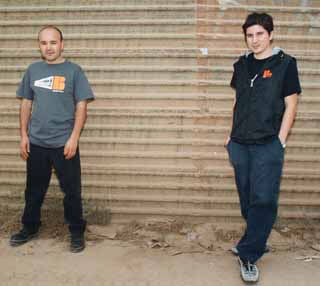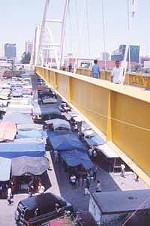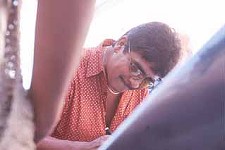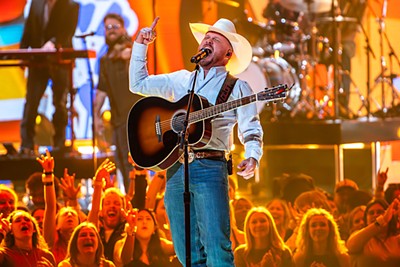Rock en Tijuana
The Bastard Child of Norteño and Electronica, Nortec, 'The Future of Mexican Music'
By Melissa Sattley, Fri., Nov. 3, 2000

Musicians Pepe Mogt and Ramon Bostich peer through a hole in the high metal wall that divides their city, Tijuana, from the United States. On the U.S. side, three cyclone fences topped with razor wire deter immigrants from the American Dream, while here in the Colonia Nido de Aguilas, junked cars decompose and half-starved dogs troll for food. A Border Patrol helicopter buzzes overhead, and in an odd moment, the pilot waves at the musicians and they wave back. Bostich points out a fence made entirely of washing-machine lids that encircles the junkyard
"It's pretty amazing isn't it?" says Bostich, admiring the fence as if it were a piece of art. "In Tijuana, everything inspires our music."
Mogt, 30, and Bostich, 37, say they aren't bothered that the outskirts of their town look like a militarized zone. Spending time in this chaotic border town of three million where gleaming new maquiladoras with names like Sony and Hitachi meet crumbling poverty is like wandering through some post-apocalyptic movie set where the third world meets the first. If Tijuana is like a surreal movie, then Mogt and Bostich have created the perfect soundtrack for this final Latin American frontier. They call it "Nortec," a hybrid of techno beats and Norteño brass and rhythms.
On weekends, Tijuana's Nortec music fans pack the Jai Alai stadium on Avenida Revolucion or the clubs an half-hour down the coast in Rosarito to dance all night to electronic groups like Mogt's Fussible or Ramon Bostich's one-man trance groove-inspired outfit Bostich. Mogt and Bostich are hesitant to call these happenings "raves," preferring instead to call them "parties" where like-minded electronic music fans meet. In the past year, Nortec has started to grow into something more than just a musical style -- it's become a full-blown movement in Tijuana, including art, design, and even architecture.
Unlike bands in Monterrey such as Genitallica (profiled in June in "The Kings of Monterrey," Vol. 19, No. 42), who have taken U.S. music styles and mixed them with their own Mexican flavor, Nortec is far more ambitious than just sex, drugs, y rocanroll. The members of the Nortec collective here in Tijuana want nothing short of a revolution. Here, musicians and artists want to vanquish the border city's reputation as a killing field for Mexican drug lords and San Diego's sin city and give it the kind of cultural credibility it's never had before as a center for music, art, and design. They also want to have fun.
The Sons of Kraftwerk
Ramon Bostich, a somewhat shy dentist with four kids, is known as the "Godfather of Nortec" largely because of his track "Polaris," which with its driving Norteño rhythms, horns, and snare, became a popular dance-floor hit in 1999.
"That track opened the Nortec sound for all of us," said Mogt in a recent interview with a UK music magazine. "Ramon showed us that the rawer the original Norteño tracks sounded, the stronger the music was."
Bostich and Mogt say that they are Tijuana's second generation of electronic musicians. Back in the early Eighties Tijuana bands like 3-D TV and Avant Garde played to small crowds of loyal electronic music listeners. A lifelong fan of electronic music, Bostich grew up listening to his brother's Tangerine Dream, Kraftwerk, and Yello albums. A longtime presence in Tijuana's electronic music scene, Bostich (aka Ramon Amezcua) started playing ambient techno in 1988 under the name Bostich, which he co-opted from a Yello song title.
It's Pepe Mogt, however, who is credited for coming up with the idea of merging traditional Norteño with electronic music. Nortec had its birth in 1998, when Mogt heard a Sinaloense (West Coast Mexican) band at a family wedding and wondered how the traditional Norteño music would sound mixed with electronic music.
"I grew up listening to punk rock and electronic music -- I hated Norteño," says Mogt. "Maybe I'm just getting older and coming back to my roots, but that's when I really started listening to the rhythms in the music for the first time."
At a music studio on Avenida Coahuila where many Norteño bands record in Tijuana, Mogt sampled horns, accordions, and snares, then distributed the samples among Tijuana's electronic musicians, including the other two members of Mogt's group Fussible, Jorge Ruiz and Roberto Mendoza (now the man behind the electronic ambient sound of Panoptica). He also gave samples to Bostich.
"The bands here really got into it and started making more and more tracks with the Norteño samples," Mogt says.
In May 1999, the Nortec sound was compiled on the Nortec Sampler, Vol. 1 and put out on Mogt, Ruiz, and Bostich's own Mil Records label. The sampler featured local electronic bands such as Fussible, Bostich, Panoptica, Hiperboreal, Clorofila, Terrestre, and Plankton.
"Before, people said electronic music here sounded like the mix of breakbeats and hip-hop that you hear in San Francisco or the UK," relates Mogt. "But with Nortec, we knew we had something very different."
The Nortec sampler caught the ear of Kim Buie, a senior executive for Chris Blackwell's new Palm Pictures label in Los Angeles. After hearing the tracks, courtesy of a friend in Mexico City, Buie promptly signed the Nortec musicians to a pressing and distribution deal. A new compilation called The Nortec Collective will be released in February, she says.
"The Nortec musicians are taking something that was considered very uncool -- Norteño music, the stuff that their parents listened to -- and are making it something new by putting their own spin on it," explains Buie. "It's a whole community of kids that have put a new spin on electronic music. I went to Nortec nights in Rosarito twice, and there were at least 1,000 kids there who came to just hang out and dance."
A New Recipe
Gilbert Guerrero, DJ for Austin's Spanish Rock Radio on KOOP 91.7FM, says he had an opportunity to see Terrestre and Bostich perform in New York City during the Latin Alternative Music Conference in August. "They played at the end of the night after almost everyone had left," he says.
There were only about 45 people left by the time the musicians came on, recounts Guerrero, and virtually no one had heard of Nortec. Some of the crowd didn't get it. Guerrero, on the other hand, says he heard the "future of Mexican music" that night and has been a fan of the music ever since.
"It was amazing," he enthuses. "It was so weird and fresh. I thought it was pure genius."
Imagine spacey ambient music punctuated by the oom pah pah of a Norteño tuba and a driving snare beat like Bostich's "Polaris" and you've got a recipe for the Nortec sound.
"It's not drum and bass, it's not deep house or trance music," says Guerrero. "It's Nortec, which could have only been created in a city like Tijuana -- home of Norteño and also the door to the United States. It's pure border music."
Marc Isenschmid, owner of an electronic music store in San Diego, agrees that it's hard to sum up the Nortec sound.

"It's very unique, because it incorporates two types of music styles -- freestyle electronic and traditional Mexican folk music," explains Isenschmid. "You either love it or hate it."
Not everybody finds samples of Los Tigres Del Norte crossed with the musical sentiments of Kraftwerk appetizing to the ear.
"I'm not sure I'd call myself a fan of Nortec," Isenschmid says, "but most people who have been into electronic music for a long time usually like it because they recognize the intelligence of it."
Enrique Rangel, bassist for Café Tacuba, one of the most innovative bands in the Rock en Español movement, says he's heard Nortec music, but is not entirely convinced he likes it.
"It's a very interesting idea, but I wish there was more Norteño and less techno," he jokes.
Kim Buie calls the Norteño influence in Nortec subtle.
"It would be hard to pinpoint it if you are not acquainted with Norteño music," she agrees.
Buie says she also recognizes the challenges that Palm Pictures will have marketing the new music genre when the CD is released in February.
"It confuses most people -- they think Nortec is a band, but calling it The Nortec Collective should help things a little."
Nortec won't actually be marketed to a mainstream audience, says Buie. Instead, Palm will target the club community and college radio. Buie, who worked for Capitol Records and was responsible for marketing Monterrey-based art-thrash masters Plastalina Mosh to a U.S. audience, says she's looking forward to the challenge.
"Marketing Plastalina Mosh was the most fun I ever had," she says. "I was working with a completely different genre of music, and I had the chance to educate U.S. listeners that something really new was coming out of Mexico."
The Factory
If music is the soul of Nortec, then art and design is the heart and mind behind the movement. Housed in a semi-abandoned shopping mall near Tijuana's airport, a cramped storefront studio called Torolab has become a creative hive for Nortec projects.
The studio, run by husband-and-wife team Raul Cardenas, 31, and Marcela Guadiana, 29, is reminiscent of Andy Warhol's Factory for its sheer span of creative ideas and productivity. The studio is filled with computers, turntables, and numerous designs for everything from clothing to houses, all fiercely protected by the couple's cranky watchdog, a Jack Russell terrier named Wookie. Here Cardenas and Guadiana work with a revolving cast of artists and musicians who design many of the CD covers, graphics, and T-shirts for the Nortec musicians.
An architect and designer, Cardenas, with his scratched-up eyeglasses and frenetic work habits, has become a sort of philosophical guru for the Nortec movement and the biggest defender of Tijuana's art scene. Tijuana, like many U.S. counterparts, is a relatively young city where people can endlessly reinvent themselves. This freedom has benefited many of the artists in the city, he says.
"It's a city where nobody is from," says Cardenas, who came to Tijuana from Mazatlan 11 years ago. "There are no chains here. Everywhere you go, you can create history. Tijuana grows so fast that the ephemeral becomes permanent very quickly. I'm an example of that. I came here to go to school 11 years ago and never left."
For the first time in Tijuana's 110-year history, Cardenas says Mexico's youth are actually viewing the border city as a place of opportunity and creativity and not just a springboard into the United States.
"This isn't just a place for people who couldn't make it in the United States," he states. "We're probably the first generation of people that have chosen to stay here."
Joselo Rangel, guitarist for Café Tacuba, says he's known Cardenas for at least seven years and the artist has always championed his adopted city.
"He shows up in Mexico City with a million things to show us -- clothes, art, music -- and he tells us everything is great in Tijuana," laughs Rangel, who calls Tijuana a world apart. "It's a country within a country."
This is precisely what drives Nortec, says Cardenas -- its otherness.
"Tijuana is very dramatic," he exclaims. "It's like a big storefront. And next door is San Diego, which is so clean and the people are so nice that it's like Pleasantville -- it's freaky."
That said, no artist or musician in Tijuana can deny the almighty influence of El Norte. Most travel to San Diego on a weekly basis to see art exhibits and buy records. Plus, they all grew up listening to American radio and watching American TV.

According to Cardenas, most Tijuana artists don't have a lot of money or resources, but are so close to the land of plenty that often San Diego's throwaway items become Tijuana's gold.
"It's like a big flea market," laughs Cardenas. "You can buy used computer parts in the United States and build your own computer. A lot of the things you see in my studio were found there or put together from parts."
Nortec, says Cardenas, is a reflection of the local musicians' creative will to remain in Tijuana and make something unique to their environment, and perhaps in the process, change the city's reputation as a stomping ground for all-night strip clubs and tacky discotheques.
"Torolab was born out of necessity," says Cardenas. "To enhance our quality of life starting with ourselves."
Even the clothes that the couple designs under the clothing line Torovestimenta reflect life on the border; today Cardenas is wearing a pair of army green pants which he designed himself. The pants have several hidden pockets; one pocket inside the waist holds a passport for easy crossing between the United States and Mexico.
"People don't understand that the border is not just here in Tijuana," he says. "It reaches from Ensenada all the way to Los Angeles."
Global Music
At Mogt and Bostich's favorite late-night taco stand on a crowded avenue in the middle of the dusty, sprawling city, the musicians reflect on Nortec's future. It's clear they have high hopes for the release of The Nortec Collective in February. Mogt has even quit his job as a chemical engineer to devote all of his time to his music. Soon, they'll take their music on the road, and the musicians hope that Nortec will put Tijuana on the map in the global electronic music scene.
"We're going to play Austria and Japan," says Mogt with excitement. "And at the Expo 2000 in Hanover, Germany, they are playing our music in the Mexico exhibit."
Mogt says that because of the Hanover exhibit they have received calls from all over Europe, music fans wanting to know where they can buy Nortec music. Meanwhile, Mogt and Bostich are working on some remixes with a French DJ called Tampopo, and UK music magazine The Wire recently wrote about the Nortec sampler for its "Global Ear" section.
Marc Isenschmid, who DJs under the name DJ Electric Sheep, says he thinks that Europe will embrace Nortec much more than the United States at first.
"They've got a better chance in Europe where the trends for electronic music are set -- places like the UK and Germany," posits Isenschmid. "There, people are more open-minded. In the United States, everything is so spread out. It takes longer for a new style to catch on."
Kim Buie echoes these sentiments, saying she thinks she'll have an easier time marketing Nortec overseas where electronic music has many staunch fans and a better commercial track record. Not that this means there's isn't a receptive audience for Nortec here in the United States. Musicians from Tijuana have already played in New York City, San Francisco, Los Angeles, and just across the border in San Diego.
"Nortec is catching on in San Diego," claims Isenschmid. "You don't need to speak Spanish to get it."
Musicians featured on The Nortec Collective may also be coming to the Lone Star state soon. Some of the collective has already applied to South by Southwest, and Austin's Latino Rock Alliance plans on showcasing the musicians during its Latino hip-hop/rave showcase in March. Mogt thinks Nortec is more accessible to non-Spanish speaking listeners than Rock en Español.
"I think we are more global than Rock en Español, because we are coming from an instrumental side -- we aren't reliant on vocals," he explains
Buie is more modest, however, about just how many barriers Nortec may break through on its initial foray into the global music market.
"We'll start with a small release of maybe 15,000-20,000 records," she says. "Like we did with Plastalina Mosh. We'll find those pockets of interest, because no one knows who they are yet."
Either way, Nortec musicians are confident about their cause and will probably continue playing their music even if they never sell a single CD. Presently, the scene is thriving in Tijuana, musicians and artists proud of Nortec, because they've created something unique that speaks of their lives in a city that for decades has been ignored as nothing more than a backwater crime-ridden border city.
"They have vision, and that can't be given to an artist," says Buie of her meetings with Mogt and Bostich, "Nortec is very grassroots and the musicians help each other out."
Joselo Rangel, of Café Tacuba, says he too has noticed that Tijuana artists and musicians tend to stick together.
"In Mexico City, you see people fighting one another, but in Tijuana they are helping each other to make something," he says.
Raul Cardenas says that people in Tijuana are used to being outsiders who live at the outskirts of both the U.S. and Mexican cultures. This outsider feeling, he says, fuels the Nortec artists and musicians. When people in Tijuana go to a bullfight, they root for the bull, not the bullfighter.
"I called our studio Torolab, because for me, the toro [bull] is the symbol of a warrior with nothing to lose -- that's the spirit you have when you live here," says Cardenas. "Everyone thinks that this city is Sodom and Gomorrah. But this place is really about breaking through barriers." ![]()







